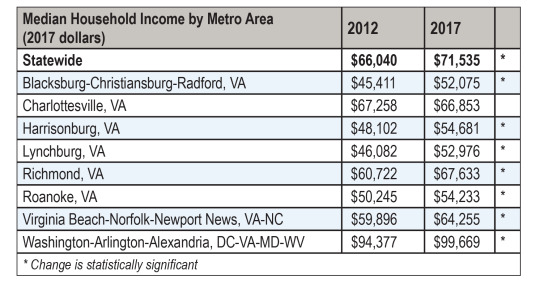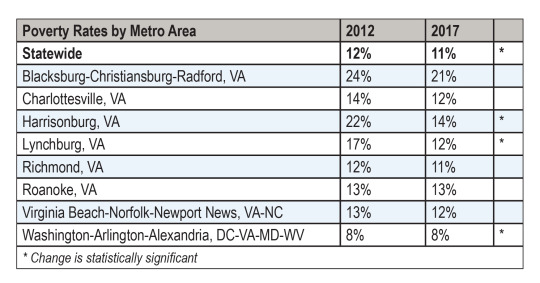September 13, 2018
New Census Income and Poverty Data: Rounding the Corner and Looking Forward to the Future
Incomes rose in Virginia for middle-class households in 2017, with household incomes finally exceeding pre-Great Recession (2007) levels. Compared to 2016, median household income is up 2.8 percent in Virginia to $71,535. Compared to five years ago (2012), when household incomes had bottomed out from the overhang of the Great Recession, Virginia’s median household income is up 8.3 percent after adjusting for inflation. And some Virginia cities and counties are doing exceptionally well – Stafford County had the second highest year-over-year dollar growth in median household income of any large locality in the United States and Alexandria City had the sixth highest growth. Loudoun County remains the highest-income large county in the United States. This is good news for most Virginia families and communities.
However, the share of Virginians with incomes below the poverty threshold remains higher than before the recession. Statewide, Virginia’s poverty rate was 10.6 percent in 2017, up from 9.9 percent in 2007 and not significantly different than the 11.0 percent rate in 2016. The share of Virginia children who are living in households with incomes below the poverty threshold was 13.7 percent in 2017. This share remains significantly above the pre-recession level of 12.7 percent, indicating that even as middle-class incomes have reached new highs, many Virginia families with children are still struggling to make ends meet. And even as the median household income increases statewide, more than 1 in 3 households in Virginia have incomes under $50,000 a year.
Although the economic expansion has significantly increased median household incomes in almost every metro area of Virginia compared to 2012, many parts of Virginia still experience far higher poverty rates and lower typical household incomes than the statewide levels. The Blacksburg, Harrisonburg, Lynchburg, and Roanoke metro areas all have median household incomes at least $15,000 below the statewide median of $71,535, with the Richmond and Hampton Roads areas also having median household incomes below statewide levels, although less dramatically. The Blacksburg, Harrisonburg, Roanoke, and Hampton Roads metro areas all also have poverty rates significantly above the statewide rate.


Despite this regional variation, the economic recovery overall is boosting incomes and reducing poverty rates for Virginians from a range of communities. Poverty rates are down significantly compared to 2012 levels for non-Hispanic white Virginians, Hispanic/Latinx Virginians, and Black/African-American Virginians, and median incomes are up significantly for non-Hispanic white, Black/African-American, and Asian-American Virginians.
Still, almost two-thirds of Virginia families with incomes below the poverty threshold have at least one adult in the household who is working, and there are around 273,000 working adults living in Virginia households with incomes below the poverty threshold, which is just $24,858 for a married couple with two children. Making Virginia’s Earned Income Tax Credit (EITC) refundable could help move already working families out of poverty and, along with raising the minimum wage, could help make work pay for single-parent families facing high costs for child care and transportation. A fully refundable state EITC would lift about 16,000 people in Virginia, including nearly 8,000 children, out of poverty.
When it comes to boosting opportunity for families and communities, the EITC is one of the most effective policies we have. Unfortunately, the state puts overly tight limits on the existing state EITC that prevents working people and their families from getting the full value of the credit they’ve earned. These credits have been shown to supplement wages and boost labor force participation, and they can also be a key step in fostering economic development.
Category:
Economic Opportunity
